 Nuclear Attack Submarines: USS Skate, Swordfish, Sargo, Seadragon SSN-578, 579, 583, 584. 1957-1995.
Nuclear Attack Submarines: USS Skate, Swordfish, Sargo, Seadragon SSN-578, 579, 583, 584. 1957-1995.
[wpcode id="44777"]
The first USN SSN class

The Skate class was the first coherent class of nuclear-powered attack submarines after two prototypes,
USS Nautilus and
USS Seawolf. The second tested a new type of sodium-cooled reactor that was not chosen for this class, following more a mixture of nautilus for the powerplant (with the reduced S3W) and the conventional Tang class for the general design. Before the Skipjacks, they were considered still the 1st generation of American nuclear attack submarines, but were useful enough to stay in service until 1986-89. USS Skate was the first to surface at the North Pole, on 17 March 1959. #coldwar #usn #ssn #nuclearattacksubmarine #submarine #submarines #unitedstatesnavy #skateclass #skate #sargo #seadragon #swordfish
Development: SCB 121, the Austere Nautilus
The Skate-class submarines became the first "production run" nuclear-powered submarines, as it was considered the concept was matured enough. They were not built AFTER USS Seawolf but about the same time. The latter was launched the same year indeed in 1957. So there was no choice of powerplant, nothing to decide about using the pressurized water-cooled or sodium-cooled technology, the choice was already made by the time of their design. The Navy considered back in early 1955 that the conventional
Tang class (also in construction at the time) was a good overall design, cheaper to built and operate, smaller and simpler than USS Nautilus, which almost was a showboat of technology.
For production the admiralty board wanted a simpler boat and thus looked at the Tangs and how to shoehorn a nuclear reactor instead of a classic diesel powerplant.
The Skate class were designed under
project SCB 121 as economical production nuclear-powered submarines (SSNs), smaller and austere than Nautilus, but designed even before Nautilus was completed, demonstrating the advantages of high, sustained underwater speed. By the time they were designed, their underwater speed was the same as the Tang class of similar displacement and close in dimensions. The core of the redesign (same plans were reused) was the compartment for their S3W reactor, a scaled-down version of the S2W reactor in USS Nautilus, and with half the power output. The admiralty classed it as the SFR (Submarine Fleet Reactor) to underline this was to be their main production reactor for the next classes.
FY56 programme, towards faster submarines
A slightly modified S4W was adopted for the two sisters of USS Skate. However soon problem emerged. Scaling down a reactor did not equate to reducing its shielding proportionally. Like the hopes placed in aviation at the time for the same propulsion concepts, downsizing was impractical at large, more so in the air due to the obvious heavy weight. But by the late 1950s, it was hoped that these nuclear-powered aircraft developed would be successful, as the USAF gained better R&D funds. Many thought they would find a way to alleviate the shielding problem and, in return, open new doors to developed very small SSNs. But it never happened. The atomic bomber proved a dead end, and in submarines, only technology will allow even further reduction in the future (like for the French Rubis class).
The rest was pretty much "stock" Tang, with an identical armament, six bow, two stern 21 inch (533 mm) torpedo tubes, an old school solution. Stern tubes had no ejection pump and were usable for swim-out weapons (by their own means), like the Mark 37 ASW homing torpedo. But after their launch, many in the Navy questioned this path for future SSNs and wanted to get all the advantages of the Nautilus, yet still in a less costly package, this and the quest for a better sonar (like the one used on USS Seawolf, a true "hunter-killer") went for a high submerged speed model, leading to the Skipjack and Thresher classes, after a stop to the USS Albacore, testing the teardrop hull to reach such speeds with the same output.
The four Skate class were the first and last SSN with stern torpedo tubes and the smallest ever built in the US, but they served for many years, decommissioned in 1989 for the last one, BU in 1995.
In the end, larger production was abandoned in favour of the
Skipjack class, through the FY56 programme.
Construction
 The Skate class (bottom) compared to the USS Nautilus (top)
The Skate class (bottom) compared to the USS Nautilus (top)
These submarines followed the WW2 and interwar tradition of US coastal waters fish names. But they were named also after famous WW2 ace submarines, to commemorate them. This will change with the famous Los Angeles class, 3rd generation SSN, due to cost and political reasons, while cruisers went back to state names. Quite a surprising swap of traditions, as the cruisers were named after cities and the battleships had the states names.
USS Skate (SSN-578) was started at Electric Boat on 21 July 1955 (laid down), launched by 16 May 1957 and completed on 23 December 1957. She was to be decommissioned on 12 September 1986 and was completely Recycled by March 1995. She was the only one built at the same yard as USS Nautilus, right after her. She was the longest to build, 13 months to launch and 21 to completion.
USS Swordfish (SSN-579) was built in parallel to her sisters, at Portsmouth Naval Shipyard, laid down on 25 January 1956 and launched on 27 August 1957, completed by 15 September 1958. She was decommissioned on 2 June 1989, the last of the class.
USS Sargo (SSN-583 jumped in numbers due to interlocked construction schedules. SS-580 was indeed USS Barbel, lead ship of the first teardrop hulled conventional attack subs and last of their type. Sargo was the only one built at Mare Island Naval Shipyard in California. She was laid down on 21 February 1956, launched on 10 October 1957 and completed on 1st October 1958. She was decommissioned on 21 April 1988, the second last.
USS Seadragon (SSN-584) was the second built at Portsmouth Naval Shipyard, laid down on 20 June 1956, and long to built, launched 16 August 1958 and completed by 5 December 1959. She was decommissioned on 12 June 1984, the first to go.
Design of the class
Hull and general design
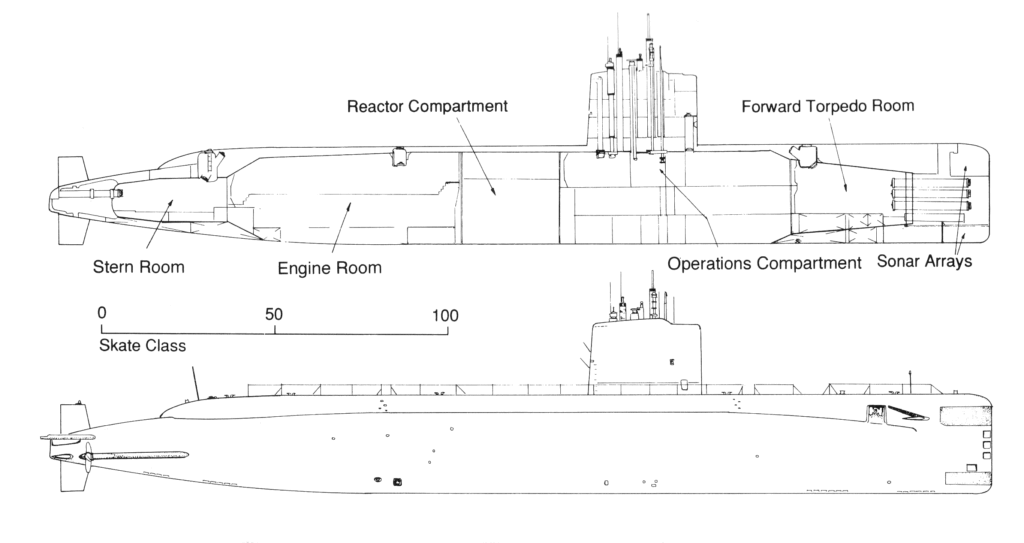
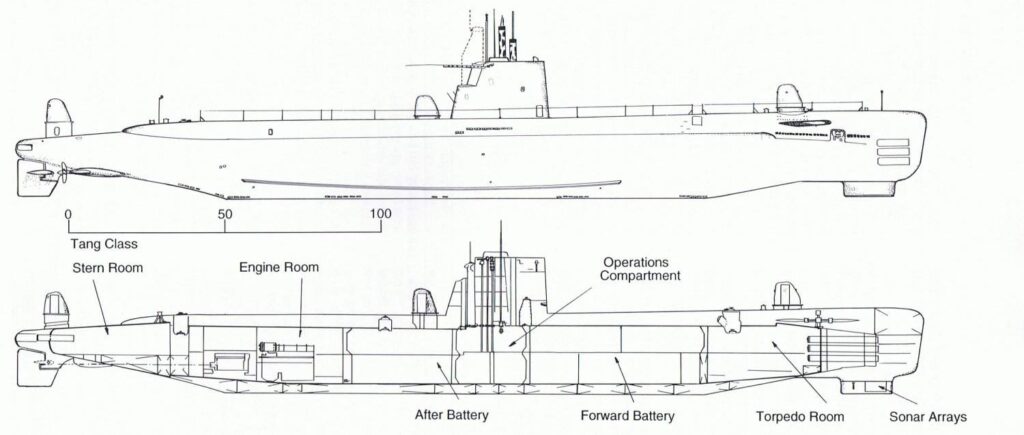
The Skate (top) and Tang (bottom) to compare.
The general outlines of the class was close to the Tang class, but with increased dimensions:
The Tangs at first displaced 1,560/2,260 long tons surfaced/submerged while the Skates displaced 2,250/2,850 long tons. This was far more, yet less than USS nautilus or Seawolf, close to 4,200 tons submerged.
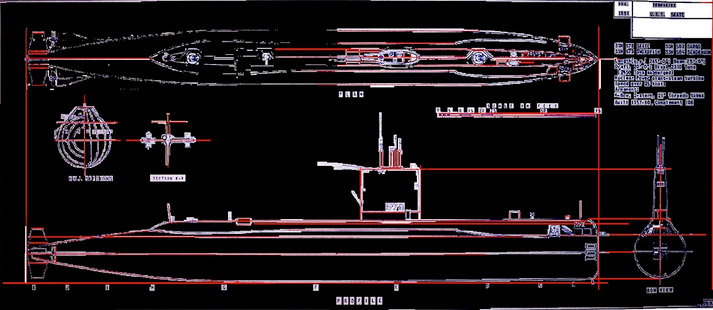
They were also beamier and much draftier: The Skate class were 267 ft 7 in (81.56 m) in lenght, 25 ft (7.6 m) in beam and 21 ft 3 in (6.48 m) in draft, versus 268/27/17 ft.
The streamlining was essentially the same as the positioning of the ballast vents and intakes. The design of the pressure hull compared to the external one was also the same, and compartimentation, with only changes at the level of the nuclear reactor. It was hoped initially to get the new SW3 reactor into the exact same compartment where were located the diesels and eliminate the batteries.
The pressure hull however was doubled for safety in some places: It was of single-Hull construction with extensive casing along the top, forward and aft parts.
Powerplant
Skate and Sargo were built with the S3W reactor, Swordfish and Seadragon also had the S3W reactor but in the S4W reactor plant with the same machinery but an alternate arrangement; The first boats thus reached as the latter 6600 hp but apparently were noted by some authors as slower, at 15.5 knots surfaced and 20 submerged, while the second pair was capable of 18 and 22 knots respectively, quite a difference. With its nuclear fuel, range was of course, unlimited. Reload of the core was every ten years at this stage.
The SW3 reactor (S – Submarine; 3 – 3rd gen; W – Westinghouse) was a variant of the Submarine Fleet Reactor (SFR) and more advanced type of pressurized water reactor (PWR) plant of USS Nautilus. It used horizontal U-tube steam generators later developed as S5W reactor plant, the common type today.
This unit powered the USS Halibut SSGN and the four Skate-class. The SW4 was only a variant of components.
Armament
Essentially the same as the Tang class: Eight 21 inch (533 mm) torpedo tubes, six forward, two aft, but a reserve of 22 torpedoes instead of 26 on the Tang class.
6x Mark 56 Bow tubes
Torpedoes at the time were likely the same models used on the GUPPY and K class, Mark 16 (Mod 3) 4,000 lb (1,800 kg), with a 746 lb (338 kg) Torpex or HBX (later used HBX-3) 960 lb (440 kg) Torpex (later used HBX) warhead and turbine (13,700 yd (12,500 m)). Later they were upgraded to heavy torpedoes when the tubes were changed.
The Mark 33 for example (1949) were acoustic (passive) models which carried 550 lbs. (249 kg) HBX to 15,000 yards (13,710 m)/27 knots. The six forward tubes were likly upgraded later to air-powered piston ejection pumps, forcing a slug of water through a slide valve behind the torpedo to make for a far quieter ejection.
The bow tubes fired later the new standard heavyweight torpedoes of US subs: The 19″ (48.3 cm) Mark 37 and Mark NT37
Introduced in 1957 for the 1st generation, Mods 0 weighted 1,430 lbs. (649 kg) for 11 ft 3 in (3.429 m) in lenght. They carried a 330 lbs. (150 kg) HBX warhead, at either 10,000 yards (9,140 m)/26 knots or 23,500 yards (21,490 m)/17 knots. They were powered by an Electric-Battery and guided by an Active and passive acoustic sonar. Later versions had an Otto fuel engine and were Wire guided.
2x Mark 57 Stern tubes
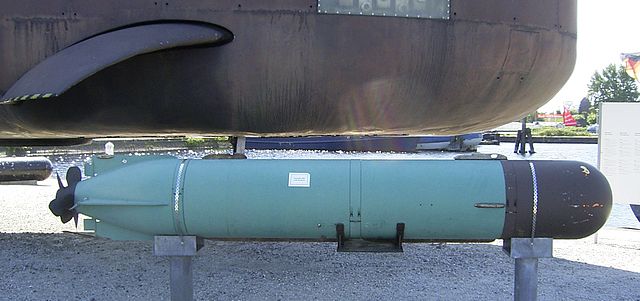
Four tubes, firing the Mark 37 torpedo featuring electrical propulsion. Entering service in the 1950s (3,300 produced) and phased out in the 1970s.
They were silent as they left the tubes by their own means, to lower acoustic signature. Several 1" thick guide studs were attached to the torpedo to ease their departure fro the tube.
The guidance of a Mk37 mod 0 used gyroscope control (initial part) and gyro control for the final straight run, after the passive sonar homing system located the target for its final 700 yards (640 m) leg using a Doppler-enabled active sonar homing (which can be heared) using with magnetostrictive transducers operating at 60 kHz, featuring miniature vacuum tubes and in the later marks solid-state semiconductor devices.
Sensors
BPS-12 radar, BQS-4, BQR-2 sonars, BLR-1 ECM suite
BPS-12 radar: The AN/BPS-12 is a medium-range pulse-only surface search and navigation radar on periscope mast. The BPS-12 is a modified BPS-5, similar to the BPS-14. Max range 74.1 km.
BQR-2 Sonar: Early type of passive cheap sonar, also shared by the GUPPY type.
BQS-4 sonar: Active/passive detection sonar with the AN/BQR-2 passive detection system and added active detection capability*.
BLR-1 ECM suite: Radar frequency tuner unit 90 MHz to 180 MHz for the electronic counter measures receiver.
*The BQS-4 active component comprised 7 vertically stacked cylindrical transducers inside the BQR-2 chin bow dome, still transmitting active "pings" but working with automatic echo-ranging or "single-ping" modes
Upgrades
Only known are in the 1960s for all the BLR-1 ECM suite coupled with the WLR-1 ECM suite. In the 1980s USS Swordfish and Sargo had both their BQS-4 sonar removed and replaced by the SQS-49 sonar (some sources), quite an upgrade in performances. The first pair were not upgraded that way.
SQS-49 sonar: No data so far.
⚙ specifications |
| Displacement | 2,250 long tons (2,290 t) surfaced, 2,850 long tons (2,900 t) submerged |
| Dimensions | 267 ft 7 in x 25 ft x 21 ft 3 in (81.56 x 7.6 x 6.48 m) |
| Propulsion | 2 shafts, 1 S3W/SW4 nuclear reactor, geared steam turbines 6,600 shp (4,900 kW) |
| Speed | 18 kn (33 km/h; 21 mph) surfaced, 22 kn (41 km/h; 25 mph) submerged* |
| Range | Unlimited |
| Armament | 8× 21 inch (533 mm) TTs, 6 fwd, 2 aft, 18+4 torpedoes |
| Sensors | BPS-12 radar, BQS-4, BQR-2 sonars, BLR-1 ECM suite |
| Test depth | 700 ft (210 m) |
| Crew | 84 officers and men |
*initially 15.5/20 kts
Read More/Src
Books
Gardiner, Robert and Chumbley, Stephen, Conway's All the World's Fighting Ships 1947-1995, p. 604, Conway Maritime Press, London:1995
Friedman, Norman (1994). U.S. Submarines Since 1945: An Illustrated Design History. NIP
Miller, David. The Illustrated Directory of Submarines of the World, p. 366.
Links
https://en.wikipedia.org/wiki/Skate-class_submarine
http://www.hisutton.com/Single-versus-Double_Hull.html
http://www.navsource.org/archives/08/05idx.htm
https://www.navysite.de/ssn/ssn578.htm
https://www.navysite.de/ssn/ssn583.htm
https://www.navysite.de/ssn/ssn579.htm
https://www.navysite.de/ssn/ssn584.htm
https://en.wikipedia.org/wiki/Skate-class_submarine
Videos
Model Kits
3D
 Skate SSN-578
Skate SSN-578
 USS Skate surfacing in the arctic, 1959
USS Skate surfacing in the arctic, 1959
USS Skate was commissioned on 23 December 1957, first captain was James F. Calvert. After a shakedown training off New London up to 29 January 1958, she went to Bermuda and back to her home port on 8 February to depart on the 24th for Portland, England, stopping in France and the Netherlands.
First visit to North Pole:
On 30 July, USS Skate went to the Arctic and made a first dive for 10 days, surfaced every day through the ice, over 2,400 miles (3,900 km). On 11 August at 9:47 pm EDT, just a week after USS Nautilus she reached the North Pole. She could not surface precisely due to dangerous ice conditions as the captain estimated the ice being too heavy and thick close to the pole. After days searched in vain for a suitable opening. She eventually surfaced for radio contact 30 nm away after assessing ice sufficiently, and managed to reach Ice Station Alpha 300 nm away, which relayed the new to the white house.
Back, she tried to stop in Denmark, shich denied access due to her nuclear nature and instead went into Bergen, Norway on 23 August. She was visited by Olav V accompanied by US ambassador Frances E. Willis, Norwefian MoD Nils Handal. Next she entered Rotterdam in the Netherlands, Anwerp, Belgium, and Brest, France then returned to New London on 25 September 1958. She earned a Navy Unit Commendation award for this feat.
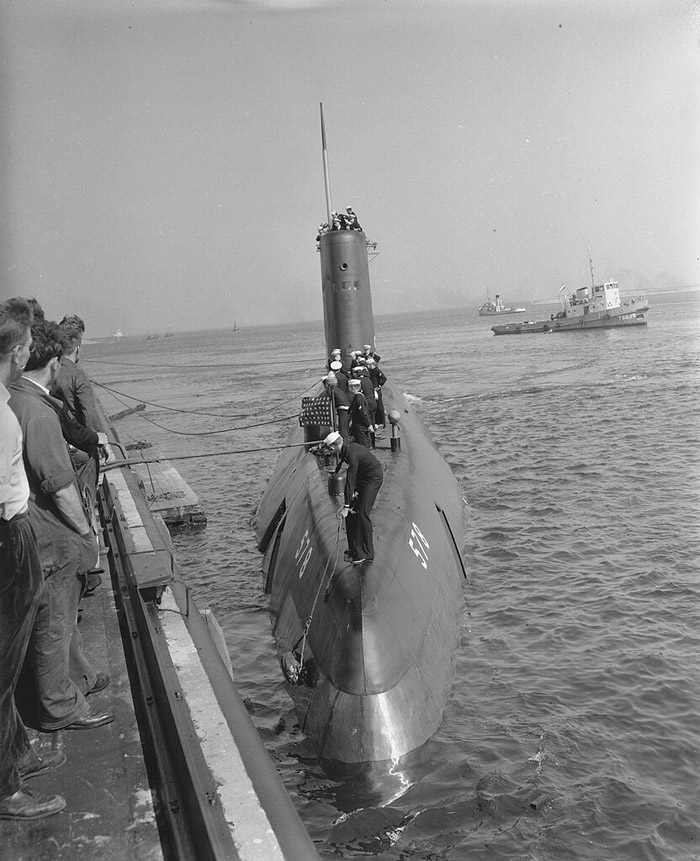
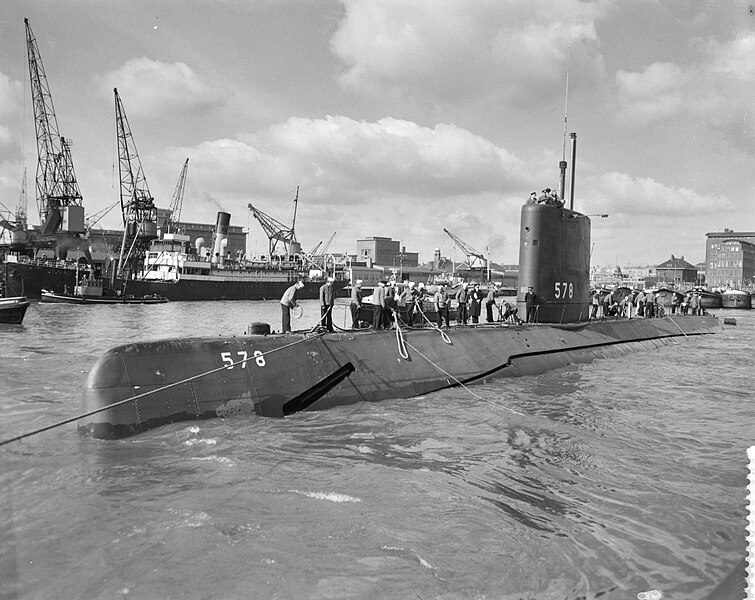 USS Skate in Den Helder (top) and Rotterdam (bottom).
Second visit to North Pole:
USS Skate in Den Helder (top) and Rotterdam (bottom).
Second visit to North Pole:
On 17 March 1959, the second attempt was this time successful: She truly became the very first submarine to surface at the North Pole. Calvert estimated that despite having still heavier ice than expected, it was worth the risk. Calvert and crew rejoiced, took photos and planted an American flag in a cairn built out of ice blocks, plus a waterproof container with a commemorating it. A ceremony was also held for Explorer Sir Hubert Wilkins, spreading his ashes as he already attempted this on the converted, first submarine Nautilus (ex-USS
O-12). Skate started afterwards to tests arctic operations and when back home, she was awarded a bronze. In the fall of 1959, 1960, she resumed standard ASW exercises with the fleet.
Next she was sent to General Dynamics Yard by January 1961 for her first regular overhaul and reactor refueled. For the next 11 months, she trained.
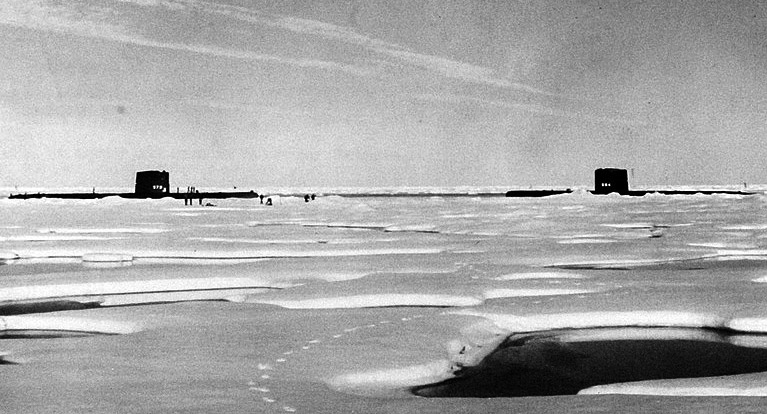
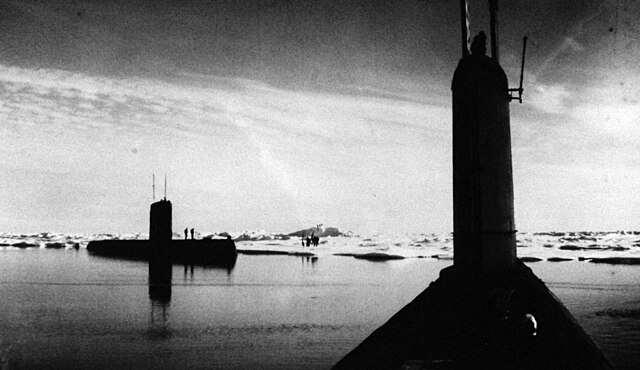 Skate and Seadragon meeting at the North Pole
Third visit to North Pole:
Skate and Seadragon meeting at the North Pole
Third visit to North Pole:
On 7 July 1962, she departed to meet USS Seadragon, which went from Pearl Harbor from an across the globe historical RDV at the north pole. The two submarines scheduled this on 31 July. It was a success again, a first, many photos and a film were made. They operated there for a week, surfacing on 2 August and receiving both congratulations from the Submarine Force Atlantic Fleet and Submarine Force Pacific Fleet.
Later carrer:
After some years to New London in fleet operations she had another makor overhaul at Norfolk on 28 April 1965, first nuclear submarine overhauled, refueling and setup of the SUBSAFE package, until September 1967. After a shakedown cruise in the Caribbean she retrurned to New London for more exercises. By October 1968, she made her first trip to the Mediterranean to work with the 6th Fleet for two months. She wold return in the Arctic in March and April 1969 as well as October 1970 and February 1971. By July 1971 she had her third overhaul at Norfolk, until 17 November 1973. In August 1974 she proceeded to resume Atlantic Fleet exercises, and by by late 1977, was transferred to Pearl Harbor, joining her sister and completing Submarine Squadron 7.
After another decade of exercizes, often combined, she was decommissioned on 12 September 1986, stricken on 30 October 1986, sent to the SSN recycling unit of Puget Sound until complete on 6 March 1995.
 USS Swordfish SSN-579
USS Swordfish SSN-579

Built at Portsmouth Naval Shipyard she was commissioned on 15 September 1958 under command of Shannon D. Cramer, Jr. After fitting out, shakedown in the Atlantic, post-shakedown availability and sea trials on the East Coast, she sailed for Pearl Harbor and arrived on 16 March 1959. She became the second SSN ever in the Pacific fleet, after her sister USS Sargo into Submarine Squadron 1 after a 35,000 miles trip, 80% submerged.
By January 1960, she sailed for her first WestPac for four months, visited in her stop in Taiwan by Republic of China Chiang Kai-shek, along a daily cruise cruise. She made a second mission on 20 June this time doing the same with Philippines Pdt. Carlos P. Garcia and local Hawaiian operations in January-May 1961. She sailed for the West Coast, trained between San Diego and San Francisco and back on 14 July before another two months mission, followed by an overhaul at Mare Island from January 1962 until her refresher on 29 September and third WestPac.
Late 1963, saw her shadowing a Soviet anti-submarine warfare exercise in the North Pacific. Detected, she could stay sublerged long enough to escape, as the game at the time was for the opposing force to make her surface. She recorded radio chatter and plotted their radar search patterns as well as photographed a Soviet Yankee-class SSBN transiting between yards for completion.
In 1964-June 1965 she was in Submarine Division 71 and then Submarine Division 11. By late late 1965, her crew was awarded a Navy Unit Commendation for special operations in 1963, 1964 and 1965.
Next she had an overhaul and core refill at San Francisco Naval Shipyard from November 1965 until 31 August 1967. After sea trials and weapons trial she trained at Hawaii until the end of the year and from January 1968 prepared for a new overseas mission to the western Pacific. On 8 March 1968, she was reported the sinking of the
Golf II class K-129, which sank northwest of Oahu. On the 17th she was in Yokosuka for emergency repairs to her bent periscope leading the press she collided with K-129 and caused her loss. The USN version was that she was damaged under pack ice in the Sea of Japan, as she was 2,000 nautical miles (3,700 km; 2,300 mi) away from the last known position of the Soviet sub. K-129 was later recovered by Hughes Glomar Explorer in 1974 in one of the most secret, costly and controversial CIA mission ever.
By May 1968, anti-nuclear activists complained when she entered Sasebo, alleging levels 20x times normal background. In the end Japanese PM Eisaku Satō banned the entry of SSNs until their safety could be guaranteed. Back home, USS Swordfish trained in local waters from 1 January to 11 May 1969 but returned in special operations from 24 February to 9 April 1970 before drydock maintenance at Pearl Harbor and crew training.
In 1971 she made another WestPac by March-September, stopping at Yokosuka, Buckner Bay, Pusan, Hong Kong and had her annual overhaul until 31 December 1973. Fast forward and by 22 June 1977, Swordfish launched a Mark 14 torpedo during a routine exercize, which bugged and started a circular run, hitting back her port screw, but did not excploded (exercise torpedo) but she had her propeller changed. She made another Westpac in October 1977-March 1978. By September 1978 the fall of a paint scraper into a torpedo launcher cost $171,000 for drydock repairs after divers failed to remove it.
In July 1979 she made another Westpac, notably stopping in Guam for a short refit but returned to have her auxiliary diesel engine muffler exhaust repaired. She was back at Pearl Harbor in December 1979. She made another Westpac in the summer of 1980 and overhaul-refueling in March 1981.
Fast forward again and by late October 1985, she had a failure of in her drain pump, replaced by the one from her sister USS Skate as scheduled for decommissioning, but while at sea, the pump failed to operat and by the evening of 23 October, water in the engine room lower reached four feet and could not be stopped evern with a portable submersible pump. The captain decided to take her shallow for pumping bilges but rushing water had a "free surface effect" and her angle reached 45 degrees.
The a fire broke in the engineroom due to water reaching the main lube oil pump motors, and a watertight door was opened to retrieve a fire extinguisher. But eventually she reached an even keel, still without propulsion. She surfaced successfully but water contamination into the feed system and steam generator could not be analyzed. After efforts, the safety of the reactors was guaranteed and the emergency diesel generator was drained and restarted before the reactor was shut down, cooled down and steam generators blown down with service air. Eventually she went back to normal 2 hours before reaching Pearl Harbor. As four air conditioning compressors were shut down internal temp. reached 80 °F (27 °C) with near 100% humidity so men had to taked turnd on the deck, surfaced to avoid collapsing inside. Until the end of 1985 she was in repairs, reactivated by January 1986, for a last WestPac. She was indeed decommissioned and stricken on 2 June 1989. She started her SRP at Puget Sound Naval, Bremerton, Washington, completed on 11 September 1995. She did not made any venture into the North Poles unlike her sisters, but more "spec ops" than her sisters, and perhaps the most decorated of the class, with a Navy Unit Commendation with seven stars, two Meritorious Unit Commendation, two Navy "E" Ribbon, the Armed Forces Expeditionary Medal and 4 campaign stars for her Vietnam Service Medal plus classified awards.
 USS Sargo SSN-583
USS Sargo SSN-583
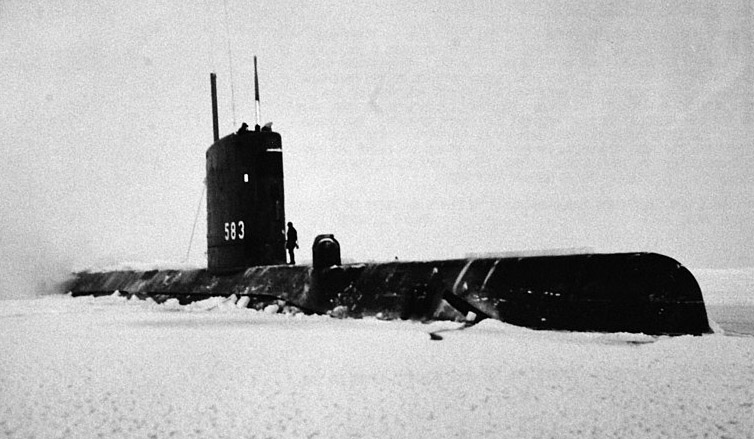
Built in Mare Island Naval Shipyard, commissioned by October 1958 under Daniel P. Brooks; But even before completion, she was designated for an Arctic cruise, with alterations to strengthen her sail and making a 19,000-mile (35,200 km) Pacific shakedown cruise to Pearl Harbor by October 1959, having scientific instruments installed to navigate under polar ice and get oceanographic and hydrographic data. After intensive training and hosting scientifics she sailed on 18 January 1960 under command of Lieutenant Commander J.H. Nicholson for her Arctic expedition.
By 25 January, off St. Matthews Island she let the icebreaker USS Staten Island (AGB-5) for a first stationary test dive surrounded by ice and by lhe last day of the months, crossed the Arctic Circle, by 9 February, she was under the North Pole, looking for thin ice and eventually surfaced 25 feet (8 m) from the pole, the closest any submarine achieved so far. The Hawaiian flag was raised at the pole and by 10 February after making experiences and collecting data she submerged for Canadian waters and ice island T-3, reached on 17 February. After more tests she sailed for the Bering Strait, Aleutian before reaching back Hawaii. On 3 March 1960 after 11,000 miles (20,000 km) including 6,003 miles (11,118 km) submerged under ice she had a hero's welcome, with precious new information on the Alpha Ridge and deep water areas in the northwest passage. Winning a Navy Unit Commendation, she was drydocked until April. She made afterwards a cruise hosting the exiled King of Nepal.
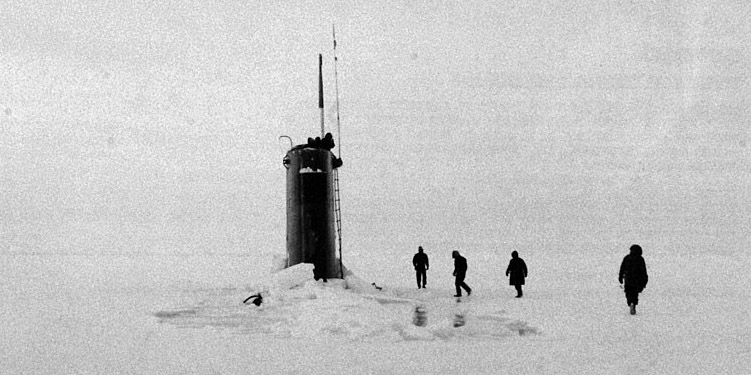 USS Sargo's kiosk emerging from the pack ice
USS Sargo's kiosk emerging from the pack ice
On 14 June while in Pearl Harbor, she hosted the King and Queen of Thailand for another cruise, but it happened when charging her oxygen tanks, the oxygen line developed a leak and a fire broke out, followed by two Mark 37 torpedo warheads detonating in "low-order" (not the main explosive fortunately) but fire spread so quick it killing the machinist's mate 3rd class James E. Smallwood (posthumous Navy and Marine Corps Medal). Flames claimed 100 feet (30 m) until blocked by the closed hatch. Shipyard teams and crew worked out the issue and extinguished it, by diving with the stern room hatch open, grounding for this in the channel, later raised by a floating crane, followed by 3 months of drydock repairs.
The rest of the crew was awarded medals and letters of commendation. After October-December 1960 training she sailed in January for the Philippines and first Westpack with the 7th Fleet. She took part in hunter-killer drills, visited Sydney and was back home in May, local ops. until July, and 2 month training cruise. By November she made a demonstration to the CNO and foreign attaches off California. In 1962 she made another westPac cruise and spec ops, earning another navy unit commendation. By July 1962 she started an overhaul until 1963, core refueled. From the summer of 1963, she had six months of local operations.
April-October 1964, she made another westPac and was sent to support Vietnam operations after the Gulf of Tonkin Incident.
By April 1965, she made another westPac and from June, EastPac. She was back home by February 1966 for a two years overhaul and refueling, earning before three more Navy Unit Commendations.
On 5 April 1968, she had a refresher training and made an extended westPac cruise, followed by others yearly (not notable incident) until 1974, alternating eastern and western Pacific cruises. She made a three fleets exercise in the South China Sea in January 1969 notably.
Fast forward and she was decommissioned and stricken on 21 April 1988, ebntering her recycling program on 14 April 1994, completed on 5 April 1995. She was the last Skate clas boat to go.
 USS Seadragon SSN-584
USS Seadragon SSN-584
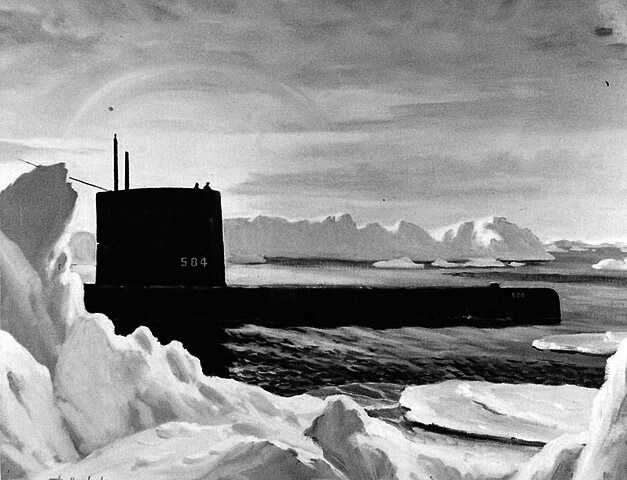
Second boat built at Portsmouth Naval Shipyard she was commissioned on 5 December 1959, colliding with a whale on October 6 during sea trials, but she won the contest... She entered service under command of Lieutenant Commander George P. Steele and after a Caribbean shakedown, had post-fixes in Portsmouth and by August 1960, sailed for the Pacific. Later she was ordered to take the Northwest Passage to Parry Channel, Lancaster Sound, the captain using Edward Parry's 1819 journal as guide, collecting oceanographic and hydrographic data until she existed the Barrow Strait, and Viscount Melville Sound, McClure Strait and by 21 August, was celebrated as the first first submarine transit of the Northwest Passage into the Beaufort Sea and North Pole, breaking surface on 25 August. She was again celebrated as the third to surface at the pole. After many scientists experiements on ice island T-3, she crossed the Chukchi Sea and Bering Strait, was in Nome, Alaska, and eneded at Pearl Harbor, being awarded the Navy Unit Commendation.
 USS Dragon at the North Pole, summer photo
USS Dragon at the North Pole, summer photo
For 9 months she was in local operations and by June 1961, started her first of many WestPacs, 7th Fleet exercises, ASW training and another submerged cruise of 58 days. 12 July 1962 saw her making a second Arctic cruise via the Bering Strait, Chukchi Sea, T-3 island and RDV with sister USS Skate departing on the other side (Atlantic) from New London, Connecticut, meeting on 31 July, under the ice and. By August they proceeded back with help of the icebreaker USS Burton Island. Seadragon off Seattle, rescued 12 survivors from a downed seaplane and she arrived home on 14 September.
After local operations and 2nd WestPac cruise she started in the summer her first overhaul and core change at Pearl Harbor Naval Shipyard, until resuming operations from May 1964, and by 10 August 1964, was rushed to the Gulf of Tonkin after the incident patrolling out of Subic Bay in September-October, stopped at Hong Kong (27 October 1964, first SSN in port) and Okinawa, Sasebo, a visit protested by China and USSR fearing SSNs will be based to Japan. On 4 March 1965 she was back home and in 1966, 1967, visited Yokosuka and fast forward later, first SSN in Hobart, Australia (January 1983). After 24 years of service (shortest of all sisters) and 200,000 miles, 1800 dives, 30 deployments, 4 under ice operation she was awarded a Navy Unit Commendation and Meritorious Unit Commendation. Inactivation commenced 1 October 1983 at Puget Sound, decommissioned on 12 June 1984, stricken on 30 April 1986, and entering the Recycling Program on 1 October 1994 until 18 September 1995.
 Nuclear Attack Submarines: USS Skate, Swordfish, Sargo, Seadragon SSN-578, 579, 583, 584. 1957-1995.
[wpcode id="44777"]
Nuclear Attack Submarines: USS Skate, Swordfish, Sargo, Seadragon SSN-578, 579, 583, 584. 1957-1995.
[wpcode id="44777"]
 The Skate class was the first coherent class of nuclear-powered attack submarines after two prototypes, USS Nautilus and USS Seawolf. The second tested a new type of sodium-cooled reactor that was not chosen for this class, following more a mixture of nautilus for the powerplant (with the reduced S3W) and the conventional Tang class for the general design. Before the Skipjacks, they were considered still the 1st generation of American nuclear attack submarines, but were useful enough to stay in service until 1986-89. USS Skate was the first to surface at the North Pole, on 17 March 1959. #coldwar #usn #ssn #nuclearattacksubmarine #submarine #submarines #unitedstatesnavy #skateclass #skate #sargo #seadragon #swordfish
The Skate class was the first coherent class of nuclear-powered attack submarines after two prototypes, USS Nautilus and USS Seawolf. The second tested a new type of sodium-cooled reactor that was not chosen for this class, following more a mixture of nautilus for the powerplant (with the reduced S3W) and the conventional Tang class for the general design. Before the Skipjacks, they were considered still the 1st generation of American nuclear attack submarines, but were useful enough to stay in service until 1986-89. USS Skate was the first to surface at the North Pole, on 17 March 1959. #coldwar #usn #ssn #nuclearattacksubmarine #submarine #submarines #unitedstatesnavy #skateclass #skate #sargo #seadragon #swordfish
 The Skate class (bottom) compared to the USS Nautilus (top)
These submarines followed the WW2 and interwar tradition of US coastal waters fish names. But they were named also after famous WW2 ace submarines, to commemorate them. This will change with the famous Los Angeles class, 3rd generation SSN, due to cost and political reasons, while cruisers went back to state names. Quite a surprising swap of traditions, as the cruisers were named after cities and the battleships had the states names.
USS Skate (SSN-578) was started at Electric Boat on 21 July 1955 (laid down), launched by 16 May 1957 and completed on 23 December 1957. She was to be decommissioned on 12 September 1986 and was completely Recycled by March 1995. She was the only one built at the same yard as USS Nautilus, right after her. She was the longest to build, 13 months to launch and 21 to completion.
USS Swordfish (SSN-579) was built in parallel to her sisters, at Portsmouth Naval Shipyard, laid down on 25 January 1956 and launched on 27 August 1957, completed by 15 September 1958. She was decommissioned on 2 June 1989, the last of the class.
USS Sargo (SSN-583 jumped in numbers due to interlocked construction schedules. SS-580 was indeed USS Barbel, lead ship of the first teardrop hulled conventional attack subs and last of their type. Sargo was the only one built at Mare Island Naval Shipyard in California. She was laid down on 21 February 1956, launched on 10 October 1957 and completed on 1st October 1958. She was decommissioned on 21 April 1988, the second last.
USS Seadragon (SSN-584) was the second built at Portsmouth Naval Shipyard, laid down on 20 June 1956, and long to built, launched 16 August 1958 and completed by 5 December 1959. She was decommissioned on 12 June 1984, the first to go.
The Skate class (bottom) compared to the USS Nautilus (top)
These submarines followed the WW2 and interwar tradition of US coastal waters fish names. But they were named also after famous WW2 ace submarines, to commemorate them. This will change with the famous Los Angeles class, 3rd generation SSN, due to cost and political reasons, while cruisers went back to state names. Quite a surprising swap of traditions, as the cruisers were named after cities and the battleships had the states names.
USS Skate (SSN-578) was started at Electric Boat on 21 July 1955 (laid down), launched by 16 May 1957 and completed on 23 December 1957. She was to be decommissioned on 12 September 1986 and was completely Recycled by March 1995. She was the only one built at the same yard as USS Nautilus, right after her. She was the longest to build, 13 months to launch and 21 to completion.
USS Swordfish (SSN-579) was built in parallel to her sisters, at Portsmouth Naval Shipyard, laid down on 25 January 1956 and launched on 27 August 1957, completed by 15 September 1958. She was decommissioned on 2 June 1989, the last of the class.
USS Sargo (SSN-583 jumped in numbers due to interlocked construction schedules. SS-580 was indeed USS Barbel, lead ship of the first teardrop hulled conventional attack subs and last of their type. Sargo was the only one built at Mare Island Naval Shipyard in California. She was laid down on 21 February 1956, launched on 10 October 1957 and completed on 1st October 1958. She was decommissioned on 21 April 1988, the second last.
USS Seadragon (SSN-584) was the second built at Portsmouth Naval Shipyard, laid down on 20 June 1956, and long to built, launched 16 August 1958 and completed by 5 December 1959. She was decommissioned on 12 June 1984, the first to go.

 The Skate (top) and Tang (bottom) to compare.
The general outlines of the class was close to the Tang class, but with increased dimensions:
The Tangs at first displaced 1,560/2,260 long tons surfaced/submerged while the Skates displaced 2,250/2,850 long tons. This was far more, yet less than USS nautilus or Seawolf, close to 4,200 tons submerged.
The Skate (top) and Tang (bottom) to compare.
The general outlines of the class was close to the Tang class, but with increased dimensions:
The Tangs at first displaced 1,560/2,260 long tons surfaced/submerged while the Skates displaced 2,250/2,850 long tons. This was far more, yet less than USS nautilus or Seawolf, close to 4,200 tons submerged.
 They were also beamier and much draftier: The Skate class were 267 ft 7 in (81.56 m) in lenght, 25 ft (7.6 m) in beam and 21 ft 3 in (6.48 m) in draft, versus 268/27/17 ft.
The streamlining was essentially the same as the positioning of the ballast vents and intakes. The design of the pressure hull compared to the external one was also the same, and compartimentation, with only changes at the level of the nuclear reactor. It was hoped initially to get the new SW3 reactor into the exact same compartment where were located the diesels and eliminate the batteries.
The pressure hull however was doubled for safety in some places: It was of single-Hull construction with extensive casing along the top, forward and aft parts.
They were also beamier and much draftier: The Skate class were 267 ft 7 in (81.56 m) in lenght, 25 ft (7.6 m) in beam and 21 ft 3 in (6.48 m) in draft, versus 268/27/17 ft.
The streamlining was essentially the same as the positioning of the ballast vents and intakes. The design of the pressure hull compared to the external one was also the same, and compartimentation, with only changes at the level of the nuclear reactor. It was hoped initially to get the new SW3 reactor into the exact same compartment where were located the diesels and eliminate the batteries.
The pressure hull however was doubled for safety in some places: It was of single-Hull construction with extensive casing along the top, forward and aft parts.
 Four tubes, firing the Mark 37 torpedo featuring electrical propulsion. Entering service in the 1950s (3,300 produced) and phased out in the 1970s.
They were silent as they left the tubes by their own means, to lower acoustic signature. Several 1" thick guide studs were attached to the torpedo to ease their departure fro the tube.
The guidance of a Mk37 mod 0 used gyroscope control (initial part) and gyro control for the final straight run, after the passive sonar homing system located the target for its final 700 yards (640 m) leg using a Doppler-enabled active sonar homing (which can be heared) using with magnetostrictive transducers operating at 60 kHz, featuring miniature vacuum tubes and in the later marks solid-state semiconductor devices.
Four tubes, firing the Mark 37 torpedo featuring electrical propulsion. Entering service in the 1950s (3,300 produced) and phased out in the 1970s.
They were silent as they left the tubes by their own means, to lower acoustic signature. Several 1" thick guide studs were attached to the torpedo to ease their departure fro the tube.
The guidance of a Mk37 mod 0 used gyroscope control (initial part) and gyro control for the final straight run, after the passive sonar homing system located the target for its final 700 yards (640 m) leg using a Doppler-enabled active sonar homing (which can be heared) using with magnetostrictive transducers operating at 60 kHz, featuring miniature vacuum tubes and in the later marks solid-state semiconductor devices.

 USS Skate in Den Helder (top) and Rotterdam (bottom).
Second visit to North Pole:
On 17 March 1959, the second attempt was this time successful: She truly became the very first submarine to surface at the North Pole. Calvert estimated that despite having still heavier ice than expected, it was worth the risk. Calvert and crew rejoiced, took photos and planted an American flag in a cairn built out of ice blocks, plus a waterproof container with a commemorating it. A ceremony was also held for Explorer Sir Hubert Wilkins, spreading his ashes as he already attempted this on the converted, first submarine Nautilus (ex-USS
USS Skate in Den Helder (top) and Rotterdam (bottom).
Second visit to North Pole:
On 17 March 1959, the second attempt was this time successful: She truly became the very first submarine to surface at the North Pole. Calvert estimated that despite having still heavier ice than expected, it was worth the risk. Calvert and crew rejoiced, took photos and planted an American flag in a cairn built out of ice blocks, plus a waterproof container with a commemorating it. A ceremony was also held for Explorer Sir Hubert Wilkins, spreading his ashes as he already attempted this on the converted, first submarine Nautilus (ex-USS 
 Skate and Seadragon meeting at the North Pole
Third visit to North Pole:
On 7 July 1962, she departed to meet USS Seadragon, which went from Pearl Harbor from an across the globe historical RDV at the north pole. The two submarines scheduled this on 31 July. It was a success again, a first, many photos and a film were made. They operated there for a week, surfacing on 2 August and receiving both congratulations from the Submarine Force Atlantic Fleet and Submarine Force Pacific Fleet.
Later carrer:
After some years to New London in fleet operations she had another makor overhaul at Norfolk on 28 April 1965, first nuclear submarine overhauled, refueling and setup of the SUBSAFE package, until September 1967. After a shakedown cruise in the Caribbean she retrurned to New London for more exercises. By October 1968, she made her first trip to the Mediterranean to work with the 6th Fleet for two months. She wold return in the Arctic in March and April 1969 as well as October 1970 and February 1971. By July 1971 she had her third overhaul at Norfolk, until 17 November 1973. In August 1974 she proceeded to resume Atlantic Fleet exercises, and by by late 1977, was transferred to Pearl Harbor, joining her sister and completing Submarine Squadron 7.
After another decade of exercizes, often combined, she was decommissioned on 12 September 1986, stricken on 30 October 1986, sent to the SSN recycling unit of Puget Sound until complete on 6 March 1995.
Skate and Seadragon meeting at the North Pole
Third visit to North Pole:
On 7 July 1962, she departed to meet USS Seadragon, which went from Pearl Harbor from an across the globe historical RDV at the north pole. The two submarines scheduled this on 31 July. It was a success again, a first, many photos and a film were made. They operated there for a week, surfacing on 2 August and receiving both congratulations from the Submarine Force Atlantic Fleet and Submarine Force Pacific Fleet.
Later carrer:
After some years to New London in fleet operations she had another makor overhaul at Norfolk on 28 April 1965, first nuclear submarine overhauled, refueling and setup of the SUBSAFE package, until September 1967. After a shakedown cruise in the Caribbean she retrurned to New London for more exercises. By October 1968, she made her first trip to the Mediterranean to work with the 6th Fleet for two months. She wold return in the Arctic in March and April 1969 as well as October 1970 and February 1971. By July 1971 she had her third overhaul at Norfolk, until 17 November 1973. In August 1974 she proceeded to resume Atlantic Fleet exercises, and by by late 1977, was transferred to Pearl Harbor, joining her sister and completing Submarine Squadron 7.
After another decade of exercizes, often combined, she was decommissioned on 12 September 1986, stricken on 30 October 1986, sent to the SSN recycling unit of Puget Sound until complete on 6 March 1995.
 Built at Portsmouth Naval Shipyard she was commissioned on 15 September 1958 under command of Shannon D. Cramer, Jr. After fitting out, shakedown in the Atlantic, post-shakedown availability and sea trials on the East Coast, she sailed for Pearl Harbor and arrived on 16 March 1959. She became the second SSN ever in the Pacific fleet, after her sister USS Sargo into Submarine Squadron 1 after a 35,000 miles trip, 80% submerged.
By January 1960, she sailed for her first WestPac for four months, visited in her stop in Taiwan by Republic of China Chiang Kai-shek, along a daily cruise cruise. She made a second mission on 20 June this time doing the same with Philippines Pdt. Carlos P. Garcia and local Hawaiian operations in January-May 1961. She sailed for the West Coast, trained between San Diego and San Francisco and back on 14 July before another two months mission, followed by an overhaul at Mare Island from January 1962 until her refresher on 29 September and third WestPac.
Late 1963, saw her shadowing a Soviet anti-submarine warfare exercise in the North Pacific. Detected, she could stay sublerged long enough to escape, as the game at the time was for the opposing force to make her surface. She recorded radio chatter and plotted their radar search patterns as well as photographed a Soviet Yankee-class SSBN transiting between yards for completion.
In 1964-June 1965 she was in Submarine Division 71 and then Submarine Division 11. By late late 1965, her crew was awarded a Navy Unit Commendation for special operations in 1963, 1964 and 1965.
Next she had an overhaul and core refill at San Francisco Naval Shipyard from November 1965 until 31 August 1967. After sea trials and weapons trial she trained at Hawaii until the end of the year and from January 1968 prepared for a new overseas mission to the western Pacific. On 8 March 1968, she was reported the sinking of the
Built at Portsmouth Naval Shipyard she was commissioned on 15 September 1958 under command of Shannon D. Cramer, Jr. After fitting out, shakedown in the Atlantic, post-shakedown availability and sea trials on the East Coast, she sailed for Pearl Harbor and arrived on 16 March 1959. She became the second SSN ever in the Pacific fleet, after her sister USS Sargo into Submarine Squadron 1 after a 35,000 miles trip, 80% submerged.
By January 1960, she sailed for her first WestPac for four months, visited in her stop in Taiwan by Republic of China Chiang Kai-shek, along a daily cruise cruise. She made a second mission on 20 June this time doing the same with Philippines Pdt. Carlos P. Garcia and local Hawaiian operations in January-May 1961. She sailed for the West Coast, trained between San Diego and San Francisco and back on 14 July before another two months mission, followed by an overhaul at Mare Island from January 1962 until her refresher on 29 September and third WestPac.
Late 1963, saw her shadowing a Soviet anti-submarine warfare exercise in the North Pacific. Detected, she could stay sublerged long enough to escape, as the game at the time was for the opposing force to make her surface. She recorded radio chatter and plotted their radar search patterns as well as photographed a Soviet Yankee-class SSBN transiting between yards for completion.
In 1964-June 1965 she was in Submarine Division 71 and then Submarine Division 11. By late late 1965, her crew was awarded a Navy Unit Commendation for special operations in 1963, 1964 and 1965.
Next she had an overhaul and core refill at San Francisco Naval Shipyard from November 1965 until 31 August 1967. After sea trials and weapons trial she trained at Hawaii until the end of the year and from January 1968 prepared for a new overseas mission to the western Pacific. On 8 March 1968, she was reported the sinking of the  Built in Mare Island Naval Shipyard, commissioned by October 1958 under Daniel P. Brooks; But even before completion, she was designated for an Arctic cruise, with alterations to strengthen her sail and making a 19,000-mile (35,200 km) Pacific shakedown cruise to Pearl Harbor by October 1959, having scientific instruments installed to navigate under polar ice and get oceanographic and hydrographic data. After intensive training and hosting scientifics she sailed on 18 January 1960 under command of Lieutenant Commander J.H. Nicholson for her Arctic expedition.
By 25 January, off St. Matthews Island she let the icebreaker USS Staten Island (AGB-5) for a first stationary test dive surrounded by ice and by lhe last day of the months, crossed the Arctic Circle, by 9 February, she was under the North Pole, looking for thin ice and eventually surfaced 25 feet (8 m) from the pole, the closest any submarine achieved so far. The Hawaiian flag was raised at the pole and by 10 February after making experiences and collecting data she submerged for Canadian waters and ice island T-3, reached on 17 February. After more tests she sailed for the Bering Strait, Aleutian before reaching back Hawaii. On 3 March 1960 after 11,000 miles (20,000 km) including 6,003 miles (11,118 km) submerged under ice she had a hero's welcome, with precious new information on the Alpha Ridge and deep water areas in the northwest passage. Winning a Navy Unit Commendation, she was drydocked until April. She made afterwards a cruise hosting the exiled King of Nepal.
Built in Mare Island Naval Shipyard, commissioned by October 1958 under Daniel P. Brooks; But even before completion, she was designated for an Arctic cruise, with alterations to strengthen her sail and making a 19,000-mile (35,200 km) Pacific shakedown cruise to Pearl Harbor by October 1959, having scientific instruments installed to navigate under polar ice and get oceanographic and hydrographic data. After intensive training and hosting scientifics she sailed on 18 January 1960 under command of Lieutenant Commander J.H. Nicholson for her Arctic expedition.
By 25 January, off St. Matthews Island she let the icebreaker USS Staten Island (AGB-5) for a first stationary test dive surrounded by ice and by lhe last day of the months, crossed the Arctic Circle, by 9 February, she was under the North Pole, looking for thin ice and eventually surfaced 25 feet (8 m) from the pole, the closest any submarine achieved so far. The Hawaiian flag was raised at the pole and by 10 February after making experiences and collecting data she submerged for Canadian waters and ice island T-3, reached on 17 February. After more tests she sailed for the Bering Strait, Aleutian before reaching back Hawaii. On 3 March 1960 after 11,000 miles (20,000 km) including 6,003 miles (11,118 km) submerged under ice she had a hero's welcome, with precious new information on the Alpha Ridge and deep water areas in the northwest passage. Winning a Navy Unit Commendation, she was drydocked until April. She made afterwards a cruise hosting the exiled King of Nepal.
 USS Sargo's kiosk emerging from the pack ice
On 14 June while in Pearl Harbor, she hosted the King and Queen of Thailand for another cruise, but it happened when charging her oxygen tanks, the oxygen line developed a leak and a fire broke out, followed by two Mark 37 torpedo warheads detonating in "low-order" (not the main explosive fortunately) but fire spread so quick it killing the machinist's mate 3rd class James E. Smallwood (posthumous Navy and Marine Corps Medal). Flames claimed 100 feet (30 m) until blocked by the closed hatch. Shipyard teams and crew worked out the issue and extinguished it, by diving with the stern room hatch open, grounding for this in the channel, later raised by a floating crane, followed by 3 months of drydock repairs.
The rest of the crew was awarded medals and letters of commendation. After October-December 1960 training she sailed in January for the Philippines and first Westpack with the 7th Fleet. She took part in hunter-killer drills, visited Sydney and was back home in May, local ops. until July, and 2 month training cruise. By November she made a demonstration to the CNO and foreign attaches off California. In 1962 she made another westPac cruise and spec ops, earning another navy unit commendation. By July 1962 she started an overhaul until 1963, core refueled. From the summer of 1963, she had six months of local operations.
April-October 1964, she made another westPac and was sent to support Vietnam operations after the Gulf of Tonkin Incident.
By April 1965, she made another westPac and from June, EastPac. She was back home by February 1966 for a two years overhaul and refueling, earning before three more Navy Unit Commendations.
On 5 April 1968, she had a refresher training and made an extended westPac cruise, followed by others yearly (not notable incident) until 1974, alternating eastern and western Pacific cruises. She made a three fleets exercise in the South China Sea in January 1969 notably.
Fast forward and she was decommissioned and stricken on 21 April 1988, ebntering her recycling program on 14 April 1994, completed on 5 April 1995. She was the last Skate clas boat to go.
USS Sargo's kiosk emerging from the pack ice
On 14 June while in Pearl Harbor, she hosted the King and Queen of Thailand for another cruise, but it happened when charging her oxygen tanks, the oxygen line developed a leak and a fire broke out, followed by two Mark 37 torpedo warheads detonating in "low-order" (not the main explosive fortunately) but fire spread so quick it killing the machinist's mate 3rd class James E. Smallwood (posthumous Navy and Marine Corps Medal). Flames claimed 100 feet (30 m) until blocked by the closed hatch. Shipyard teams and crew worked out the issue and extinguished it, by diving with the stern room hatch open, grounding for this in the channel, later raised by a floating crane, followed by 3 months of drydock repairs.
The rest of the crew was awarded medals and letters of commendation. After October-December 1960 training she sailed in January for the Philippines and first Westpack with the 7th Fleet. She took part in hunter-killer drills, visited Sydney and was back home in May, local ops. until July, and 2 month training cruise. By November she made a demonstration to the CNO and foreign attaches off California. In 1962 she made another westPac cruise and spec ops, earning another navy unit commendation. By July 1962 she started an overhaul until 1963, core refueled. From the summer of 1963, she had six months of local operations.
April-October 1964, she made another westPac and was sent to support Vietnam operations after the Gulf of Tonkin Incident.
By April 1965, she made another westPac and from June, EastPac. She was back home by February 1966 for a two years overhaul and refueling, earning before three more Navy Unit Commendations.
On 5 April 1968, she had a refresher training and made an extended westPac cruise, followed by others yearly (not notable incident) until 1974, alternating eastern and western Pacific cruises. She made a three fleets exercise in the South China Sea in January 1969 notably.
Fast forward and she was decommissioned and stricken on 21 April 1988, ebntering her recycling program on 14 April 1994, completed on 5 April 1995. She was the last Skate clas boat to go.
 Second boat built at Portsmouth Naval Shipyard she was commissioned on 5 December 1959, colliding with a whale on October 6 during sea trials, but she won the contest... She entered service under command of Lieutenant Commander George P. Steele and after a Caribbean shakedown, had post-fixes in Portsmouth and by August 1960, sailed for the Pacific. Later she was ordered to take the Northwest Passage to Parry Channel, Lancaster Sound, the captain using Edward Parry's 1819 journal as guide, collecting oceanographic and hydrographic data until she existed the Barrow Strait, and Viscount Melville Sound, McClure Strait and by 21 August, was celebrated as the first first submarine transit of the Northwest Passage into the Beaufort Sea and North Pole, breaking surface on 25 August. She was again celebrated as the third to surface at the pole. After many scientists experiements on ice island T-3, she crossed the Chukchi Sea and Bering Strait, was in Nome, Alaska, and eneded at Pearl Harbor, being awarded the Navy Unit Commendation.
Second boat built at Portsmouth Naval Shipyard she was commissioned on 5 December 1959, colliding with a whale on October 6 during sea trials, but she won the contest... She entered service under command of Lieutenant Commander George P. Steele and after a Caribbean shakedown, had post-fixes in Portsmouth and by August 1960, sailed for the Pacific. Later she was ordered to take the Northwest Passage to Parry Channel, Lancaster Sound, the captain using Edward Parry's 1819 journal as guide, collecting oceanographic and hydrographic data until she existed the Barrow Strait, and Viscount Melville Sound, McClure Strait and by 21 August, was celebrated as the first first submarine transit of the Northwest Passage into the Beaufort Sea and North Pole, breaking surface on 25 August. She was again celebrated as the third to surface at the pole. After many scientists experiements on ice island T-3, she crossed the Chukchi Sea and Bering Strait, was in Nome, Alaska, and eneded at Pearl Harbor, being awarded the Navy Unit Commendation.
 USS Dragon at the North Pole, summer photo
For 9 months she was in local operations and by June 1961, started her first of many WestPacs, 7th Fleet exercises, ASW training and another submerged cruise of 58 days. 12 July 1962 saw her making a second Arctic cruise via the Bering Strait, Chukchi Sea, T-3 island and RDV with sister USS Skate departing on the other side (Atlantic) from New London, Connecticut, meeting on 31 July, under the ice and. By August they proceeded back with help of the icebreaker USS Burton Island. Seadragon off Seattle, rescued 12 survivors from a downed seaplane and she arrived home on 14 September.
After local operations and 2nd WestPac cruise she started in the summer her first overhaul and core change at Pearl Harbor Naval Shipyard, until resuming operations from May 1964, and by 10 August 1964, was rushed to the Gulf of Tonkin after the incident patrolling out of Subic Bay in September-October, stopped at Hong Kong (27 October 1964, first SSN in port) and Okinawa, Sasebo, a visit protested by China and USSR fearing SSNs will be based to Japan. On 4 March 1965 she was back home and in 1966, 1967, visited Yokosuka and fast forward later, first SSN in Hobart, Australia (January 1983). After 24 years of service (shortest of all sisters) and 200,000 miles, 1800 dives, 30 deployments, 4 under ice operation she was awarded a Navy Unit Commendation and Meritorious Unit Commendation. Inactivation commenced 1 October 1983 at Puget Sound, decommissioned on 12 June 1984, stricken on 30 April 1986, and entering the Recycling Program on 1 October 1994 until 18 September 1995.
USS Dragon at the North Pole, summer photo
For 9 months she was in local operations and by June 1961, started her first of many WestPacs, 7th Fleet exercises, ASW training and another submerged cruise of 58 days. 12 July 1962 saw her making a second Arctic cruise via the Bering Strait, Chukchi Sea, T-3 island and RDV with sister USS Skate departing on the other side (Atlantic) from New London, Connecticut, meeting on 31 July, under the ice and. By August they proceeded back with help of the icebreaker USS Burton Island. Seadragon off Seattle, rescued 12 survivors from a downed seaplane and she arrived home on 14 September.
After local operations and 2nd WestPac cruise she started in the summer her first overhaul and core change at Pearl Harbor Naval Shipyard, until resuming operations from May 1964, and by 10 August 1964, was rushed to the Gulf of Tonkin after the incident patrolling out of Subic Bay in September-October, stopped at Hong Kong (27 October 1964, first SSN in port) and Okinawa, Sasebo, a visit protested by China and USSR fearing SSNs will be based to Japan. On 4 March 1965 she was back home and in 1966, 1967, visited Yokosuka and fast forward later, first SSN in Hobart, Australia (January 1983). After 24 years of service (shortest of all sisters) and 200,000 miles, 1800 dives, 30 deployments, 4 under ice operation she was awarded a Navy Unit Commendation and Meritorious Unit Commendation. Inactivation commenced 1 October 1983 at Puget Sound, decommissioned on 12 June 1984, stricken on 30 April 1986, and entering the Recycling Program on 1 October 1994 until 18 September 1995.